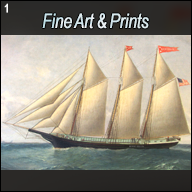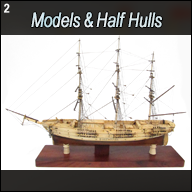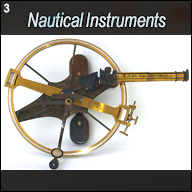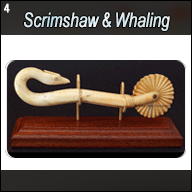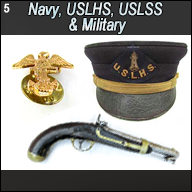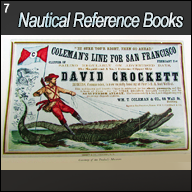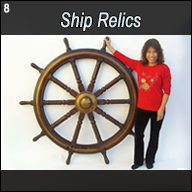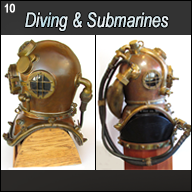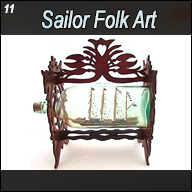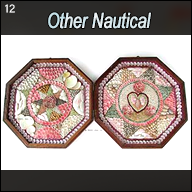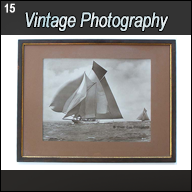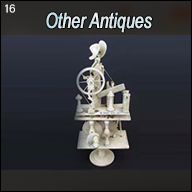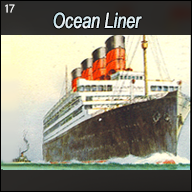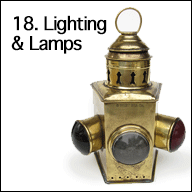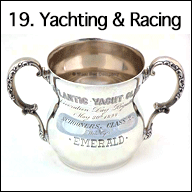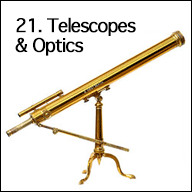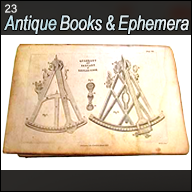Hall of Fame
OUTSTANDING NAUTICAL ANTIQUES AND ART SOLD FROM THIS WEBSITE
Page 5 of 7
Pages « 1 2 3 4 5 6 7 »
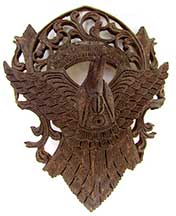
|
SUPERB P.O.W. GAME BOX. Late 18th or very early 19th century carved game casket as produced by French prisoners in British prisons during the Napoleonic Wars. This exquisite example of these artisans' output consists of a wooden box overlaid by carved beef bone panels secured with tiny sterling silver pins. The sliding top features a domed lid with "heart" handle which is carved with a helmeted warrior and his lady both attired in neo-classical dress. The execution and detail of this carving is simply phenomenal! Sliding back this lid reveals the interior divided into 3 compartments lined in red paper. The largest compartment contains a complete set of 28 tiny bone dominoes. The smaller second and third compartments, now empty, may have contained playing cards or other gaming devices. However one does contain the old hand written label reading "LADY GRANTLEY." Both sides of this remarkable game box bear delicately reticulated hunting scenes depicting a trumpeter with hounds, birds, and a rabbit. Each end is further embellished with carved urns, foliage, draped details, stars, and a diamond. In testament to its quality, each side of this lovely box is backed by 24 kt gold foil! 6 1/2 inches long by 3 inches wide and 2 1/2 inches tall. Condition is outstanding in all respects. Circa 1800.
YACHT CANNON. Incredible, turn-of-the-last-century American saluting cannon made by the "Naval Company" as indicated by the maker's plaque affixed to the top of the breech. The massive solid bronze barrel is loaded by means of a sliding breech block which is securely locked into the firing position with a massive revolving handle. The charge is percussion fired by means of a a pivoting hammer actuated by a lanyard. The barrel is mounted on trunions fitting in a revolving bronze yoke atop the original aluminum pedestal. The pivoting yoke allows the cannon to be slewn in any direction of train and elevation and is further equipped with a heavy bronze locking lever to secure the cannon at the desired angle of train. Attached to the side of the barrel is a stout, cushioned brace making it easier for the user to aim and fire. This amazing cannon has a bore of 1 3/4 inches with the barrel measuring 43 inches long. As shown here the entire unit stands 58 inches tall and is 56 inches long overall with brace. The pedestal base measures 21 inches in diameter. Outstanding original condition. The most impressive cannon of its type that we have ever seen offered for sale!
The Naval Company of Philadelphia, Pennsylvania (formerly "Hall Co.") received approval from the U.S. Government to produce their model of lifesaving gun in 1919.
RARE RUNNING LAMP. Very, very scarce mid-19th century combination running lamp for use on a small vessel. This all brass, probably American, navigational lantern incorporates the features of a masthead light with port and starboard running lights all in one. The latter consist of heavy red and green bull's eye lenses made of plano-convex glass set into circular brass retainers protruding from the sides of the lamp. The rectangular convex lens in the center is obviously of hand-blown glass with its numerous bubbles and striations. Above the lenses are their respective markings: "STARBOARD, MASTHEAD and PORT" embossed on banner-like brass tags. The chimney of this lantern is pierced all `round with decorative ventilation slits capped by a castellated top fitted with a very heavy pivoted carrying ring. Access to the lamp is gained via the rear hinged door with innovative sliding pin closure. The interior retains its original font and burner which slide into the lamp on a brass track. The burner itself has a wick advance knob in the shape of a flower and is marked "CONVEX, Pat. Jan 1, 1861." This lamp was never intended to be hard-mounted to a bulkhead -- there is no bracket. Rather it was set atop the pilot house or other ship structure. To these ends there are spacers and ventilation holes on the bottom to allow for proper aspiration when resting flat. This old veteran of the sea stands 10 1/2 inches tall (exclusive of ring), 9 1/2 inches wide and 5 inches deep. It remains in a truly remarkable state of original preservation with a lovely statuary bronze age patina. This is only the second such lamp, being the smaller of the two, that we have encountered in our 31 years in the nautical antique business. About 150 years old!
IMPORTANT SCRIMSHAW. Very significant mid-19th century American scrimshaw on a large sperm whale tooth. This classic example of the scrimshander's artistry is engraved with a large full-rigged 3-masted sailing ship under sail at sea. It streams a commissioning pennant from the main mast and the stars at stripes aft. The commissioning pennant suggests that this is an American man-o-war dating prior to the Civil War. The reverse shows the all important whaling scene so prized by collectors. This particularly pleasing portrayal depicts two whaleboats with gaff sails and 4 oarsmen pulling hard in hot pursuit of a pod of whales -- a classic scene known as "The Chase." Boat steerers stand at the tillers of each whaleboat while harpooners are in the bows. In the forward boat the harpooner is shown ready to dart with a double flu harpoon. In the after boat, the harpooner has two such irons readied. At least 5 sperm whales are depicted and all of them are spouting! The entire scene is "framed" within a tent-like border, pointed at the top and extending nearly to the ends of this big tooth. It measures over 9 inches long, is nearly solid and weighs over 1 1/2 pounds. This extraordinary piece of authentic scrimshaw is in perfect original preservation with no cracks or chips. It has a nice original surface with expected (desired) slight surface wear and a light mellow age patina. They don't come much nicer than this!
Two elements of this scrimshaw suggest a date of circa 1850. The first is the portrayal of an American Naval warship under sail with no auxiliary steam propulsion. The second is the depiction of double flu harpoons vs. toggle types.
BLACK-OUT LANTERN. Very scarce turn-of-the-last century shipmate's deck lantern. This all brass hand inspection lamp is impressed "I BLICKMAN, N.Y." on the canopy and contains its original heavy ribbed glass globe. It has a protective "cage" encircling the globe and the original press-in, spring-loaded font with burner marked "SIMPLEX, E. Miller Co., Made in U.S.A." What makes this lamp so very rare is the existence of a "light curtain" which allowed the officer to douse the light without extinguishing the flame! This feature was particularly crucial on deck when underway, as an unshielded light might be misinterpreted as a signal or mistaken for a running lamp by a passing vessel. Equally important, it allowed the officer to easily "turn the lamp back on" when the black-out condition no longer existed! This lamp has a large wire bail handle for carrying and stands 18 inches tall overall (12 inches exclusive of the handle) and 7 inches in diameter at the base. Outstanding, totally complete, polished condition. A wonderful, extremely rare American marine lantern, the first of its type we have seen.
CURTAIN |
SCRIMSHAW NARWHAL CANE. Magnificent 19th century scrimshaw sailor's cane constructed from the mythic unicorn-like "horn" of the narwhal. Incredibly, this hefty walking stick is actually constructed entirely of two whale's teeth! The shaft itself is made of the solid end section of a large narwhal tusk while the massive knob is carved from a single large sperm whale's tooth. The lovely octagonally-faceted handle is inlaid with a circle of baleen on the top with a matching baleen separator between the handle and shaft. The gracefully tapering spiral shaft terminates in its original brass ferrule with iron tip. This cane measures 37 1/2 inches long and is 1 3/4 inches thick at the widest. Condition is superb and original, with all surfaces having acquired a mellow, genuine age patina through the years. Certainly one of the rarest and finest examples of a genuine 19th century whaleman's cane currently on the market!
TOBACCO BOX LOG. Extremely rare mid-18th century Dutch sailor's tobacco box made with the dual purpose of being a ship's speed log! This authentic 1700's brass and copper container has a hinged lid which snaps closed with a press fit. The top, bottom and front of the box are profusely hand-engraved with decorative vignettes and the all important tables. On the top is engraved a representation of Julius Caesar and the words "45 before Christ." At the other end Pope Gregory is depicted with "1582." 45 B.C. and 1582 A.D. are the effective dates of the Julian and Gregorian calendars. Between is a perpetual calendar and the actual date of the box "1762." On the bottom is engraved the likeness of Amerigo Vespucci and the date "1497." With it is table by which a chip of wood when tossed into the sea could be timed as it traversed the distance between two marks on the vessel's side to compute its speed. On the side of the box is the name of the navigation school "Regt Door Zee" in Amsterdam run by Pieter Hom, the designer of the box. The condition of this box is very good, noting that some of the engraving is worn from two and a half centuries of handling and there are a couple of small losses on the hinge. 7 inches long, 2 inches wide and 1 1/4 inches thick. This truly is a very important and very scarce example of an early sailor's multi-use personal item!

|
SCRIMSHAW PIE CRIMPER. Extraordinary mid-19th century scrimshaw pie crimper or "jagging wheel" with a very unusual mechanical feature. This lovely example of whaleman's folk art is constructed entirely out of whale tooth ivory! It consists of a large reticulated handle laminated in three sections and secured with silver rivets. "The two sides are reticulated with "half moon" forms on the top with half moons and a finely cut-out floral design on the reverse. The handle is riveted to the gracefully-tapered support struts which house the rotating wheel. The wheel itself is a remarkably delicate "star" radiating from a silver rivet in the center, which acts as the hub pivot. The rim of the wheel is finely crenelated with two concentric rings. What is most remarkable about this lovely crimper is the retractable ivory utensil contained within the handle! The delicate 4-tined fork is decorated with a cut-out heart and floral designs. It extends or retracts by pushing on a coin silver "heart" traveling in a slot the length of the handle and can be locked into place by rotating the heart slightly. This superb example of "scrimshaw engineering" measures 7 inches closed and 9 inches long fully extended. The wheel diameter is 2 1/8 inches. Condition is excellent. The ivory surfaces have a mellow age patina. There are some minor age checks in the handle, none of which affect its stout integrity. The fork slides in and out properly, but is stiff in doing so due to slight age warpage. The same is true of the wheel. These common age characteristics of antique scrimshaw are to be expected and are quite acceptable for an implement 150+ years old.
In our view there is at least a possibility that the whale ivory fork is an early replacement. It is mortised into the block of ivory contained within the handle, which attaches to the silver heart. If so, it was beautifully done a long time ago, and exhibits actual use. If original, it is simply the way the whaleman chose to construct the crimper. The wheel support strut is mortised into the handle in the same fashion.
IMPORTANT AMERICAN COMPASS. Very rare, likely late 18th century, American boxed, wooden bowl compass by Samuel Thaxter, Boston. This early Federal period American boxed ship's compass has a beautifully engraved paper card signed around the center brass pivot "S. THAXTER, MAKER, State Street, Boston" with a 5-pointed star. The Northpoint is marked by a very elaborate and patriotic emblem denoting draped flags fronted by a Union shield surmounting an old fashioned anchor. The compass rose shows the cardinal points and is divided to 1/8th points. Indicative of its early origins, the card has a decorated East. It is housed in its original turned wooden bowl in original green paint, sealed under the original old wavy glass with reddish-white putty. The entire bowl measures 7 1/2 inches in diameter and rests in its brass gimbal housing with a gravity fit. The early form gimbal is hand wrought out of brass strips riveted together and fastened with screws into the box. This relatively primitive arrangement nonetheless provides the compass with a surprisingly sensitive gimbal action, and when tipped the compass will rock for several minutes before finally coming to rest! The large wooden box is of hand dove-tailed pine construction measuring nearly 10 inches square and 6 1/2 inches high. It originally accommodated a sliding lid which is long since away. This very early American boxed compass is in outstanding, unmodified condition. It is functional (although the internal bar magnets are weak) and exhibits great age with no damage. A world class museum piece of the first order!
Samuel Thaxter was born in Hingham, Massachusetts in 1769 and apprenticed to William Williams, maker of a backstaff in 1768 with a King Street, Boston address. Upon Williams' death in 1792 Thaxter took over the nautical instrument making business, moving to State Street, Boston in 1796. His address was first advertised as "51 State Street" in 1806. During the 18th century, prior to the advent of street numbers, a business location was quite often identified by a landmark, such as "At the sign of the Little Admiral" or "Near Long Wharf." The lack of a street number on this compass indicates a date very early in Thaxter's manufactory.
The earliest usage of the compass in the Western world took place during the Crusades from Europe to the Holy Land in the 11th century A.D., and it was during these Crusades east that the Christian cross became symbolic of the "East" point on the compass rose. The tradition of the "decorated East" point remained with mariners until the 18th century.
This compass was on display in the San Diego Maritime Museum as part of an exhibit entitled "When California Was An Island" showcasing early maps and instruments of navigation from the 15th through 19th centuries. An official letter verifying that this compass has museum exhibition provenance was provided.
SCRIMSHAW PIE CRIMPER. Simply superb 19th century American scrimshaw jagging wheel. This lovely example of the whaleman's art is sculpted from a single piece of whale ivory -- there is no joinery. As such it was carved out of a huge sperm whale tooth! The graceful snake-like form terminates with an eagle's head handle that measures slightly over 7 inches in length. The finely crenelated whale ivory wheel measures 2 inches in diameter and is pinned to the handle with the original copper rivet. The entire crimper is in an outstanding state of original preservation with a mellow age patina. There are the usual tiny age checks in the ivory as expected, however none affect the integrity. Complete with a high quality custom-made display stand 8 inches long. A stunning example of this form of scrimshaw!
Provenance: Nantucket Island
IMPORTANT PAINTING. Antonio Nicolo Gasparo Jacobsen (1850-1921), Danish-American, oil on heavy artist's board of the passenger steamer ATLANTA underway at sea with pennants and flags flying. A classic Jacobsen broadside portrait which pleasingly portrays the famous Chesapeake Line steamer plying a placid sea off the southeast coast of the United States. This painting certainly ranks of one of this prolific artist's best renderings, with tight execution and attention to detail. It is boldly signed and dated lower right, "Antonio Jacobsen. 1906 31 Palisade Av West Hoboken. NJ". The large format painting measures 22 by 36 inches sight and is housed in its very nice, period ornate frame 28 by 42 inches. Condition is excellent. The painting has been professionally cleaned and conserved. When viewed under ultraviolet light, there are indications of some inpainting in the sky. The vessel is completely untouched. Most importantly this painting is completely stable and does not suffer from losses or exfoliation, as do a preponderance of Jacobsen's works from the period in this medium.
Provenance: Ex. collection National Maritime Museum (Mariners' Museum), Newport News, Virginia. Literature: Sniffen, "The Checklist" 1984, The Mariners' Museum, number 39/12. An original letter from John B. Hightower, Director and CEO of the Mariners' Museum, certifies the provenance of this painting and will be provided to the purchaser.
DIVING HELMET. Authentic, first half of the 1900's American shallow water diving helmet made by the "Miller Dunn Company, Miami, Florida" as indicated on the embossed maker's plate on the right front of the helmet. This classic "Style 3 Divinhood" is of contoured spun copper with heavy solid brass cast fittings. It is in absolutely mint condition. It does not appear that it was ever used and still retains more than 95% of its factory-applied red lead coating!
In his pictographic reference book on hard hat diving, "Helmets of The Deep," 1988, Lyons, Hollywood, Florida, author Leon Lyons shows a highly polished example of the "Style 3 Divinhood" on page 116. On the Internet at: http://www.divingheritage.com/swmillerdunnkern.htm another Style 3 Divinhood is pictured with the caption "One for the road. This beauty shines like a new one." That helmet, originally purchased from West Sea Company, is an example of how beautiful such helmets look when highly polished. However it is NOT like a "new one" since helmets originally came from the factory coated in red lead paint and were never polished. The Miller Dunn shallow water helmet series began with the "Style I" in 1916 and evolved into the "Style 3 Divinhood" by 1940. The Miller Dunn Company also produced the traditional Mark V deep water helmet in limited quantities for the U.S. Navy during World War II. By the 1950's the company had ceased production.
CARVED WALRUS TUSK. Absolutely incredible 19th century carved walrus tusk depicting a Samurai warier carrying two small boys and standing atop a Fu Lion. This amazing example of the ivory carver's art is meticulously executed in an utterly charming style, rich with character! It is signed on the bottom in Kanji characters and stands slightly over 9 inches tall by 2 1/2 inches thick. Perfect condition. A rare period example of highly sought after Japanese ivory carving work in a scrimshaw medium. Without a doubt this is the finest example of walrus tusk carving that we have ever seen!
IDENTIFIED SHIP'S FIGUREHEAD. Spectacular 19th Century carved and painted wooden ship's figurehead from the North American bark EDINBURGH. This stunning example of the ship carver's art is dressed in classical attire, adornmed with a ribbon-carved gilt necklace and tiara, central oval brooch and bracelets on each wrist. She poses a striking stance, forward leaning with her right arm across her bosom as she stands on the original base, flanked by Acanthus scrolls. This important artifact was sculpted by the well known Canadian wood carver John Rogerson (1837-1925) who worked in St. John, New Brunswick in the second half of the 19th century. The figurehead stands 73 inches tall inclusive of its small wooden display pedestal and weighs approximately 400 pounds. It is in an outstanding state of preservation with approximately 90% original surfaces and paint.
The EDINBURGH was a Canadian-built and registered 3-masted barque of 203 1/2 feet launched by William Charland, Jr. of St. Joseph de Levis Quebec, Canada in 1883. After 26 years of service, she met her demise in the port of Bermuda where she foundered in 1909. This figurehead was first owned by the American Consul to Bermuda, William H. Allen and was proudly displayed in his garden for several years. In the 1920's she became the property of Francis Turnbull Meyer, a successful businessman from New York. Mr. Meyer, long a patron of the arts, donated the figurehead to the Addison Gallery of American Art at the Phillips Academy, Andover, Massachusetts in 1933 where it was on public exhibit in the Maritime Wing until 2002.
This famous figurehead is well documented in associated literature. In the book "Shipcarvers of North America," M.V. Brewington, 1962, Barre publishing Co., Barre, Massachusetts, the entire page 94 is devoted to a full length photograph of the figurehead with accompanying text. In the landmark work "Treasury of American Design" by Clarence Hornung, published by Abrams, Inc., New York, 1976, the first chapter is entitled "Forgotten Figures Fore and Aft." The frontispiece of chapter I, page 6, is the full page image of this beautiful figurehead

|
SUN DIAL. Genuine late 17th or very early 18th C. portable dial of the Butterfield type constructed entirely of sterling silver and signed "Chapoto, "Paris" This diminutive horizontal dial is constructed in the classic Butterfield form with bird gnomon allowing for adjusting the instrument for the observer's latitude and with inset magnetic compass showing the cardinal points. The tablet is engraved with three hour bands, the outer delineated by Roman numerals and the inner two in Arabic. The inner bands are divided by half hour intervals, whereas the outer is divided down to 15 minutes, and is additionally marked "Pour 50 Degre." The reverse of the dial is very handsomely decorated with engraved floral designs and the latitudes of the prominent cities of Europe such as "Marseille 43 (sic), Rome 42, Vienne 49 (sic), Londres 51 (sic), etc. A leaf spring stop on the bottom is linked to the gnomon to retain it in a perpendicular position while in use. Measuring a mere 1 1/4 inches wide by 2 3/8 inches long, this instrument is in exceptionally fine condition throughout.
Michael Butterfield was an English scientific instrument maker who settled in Paris in 1677. Soon thereafter his workshop began to produce a very popular miniature dial with an octagonal base and a distinctive triangular gnomon supported by a bird, the beak of which indicated declination for latitude. So popular were these instruments that they became know as "Butterfield dials" despite the fact that several other makers produced them. The rare example offered here is oval in form, unique amongst such dials of the era, and probably quite early.

|
Page 5 of 7


